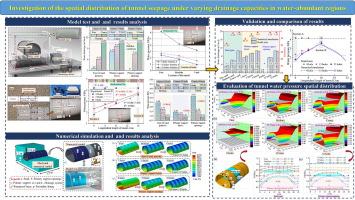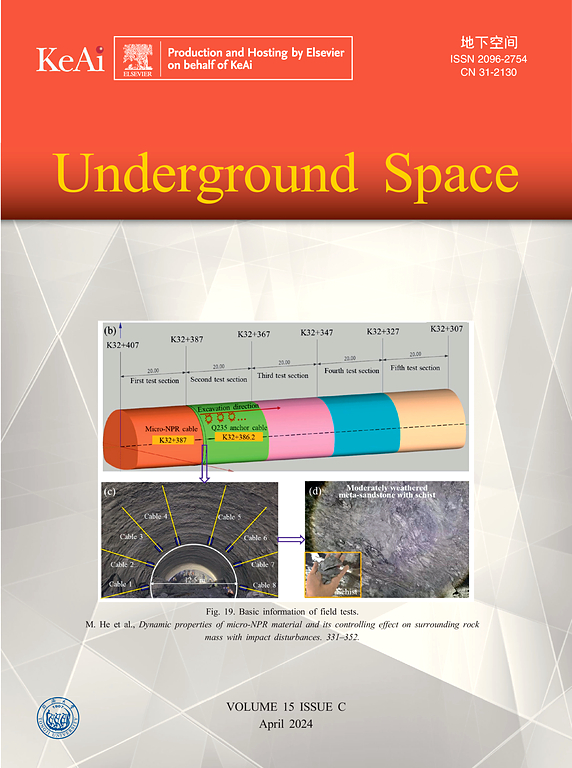Investigation of the spatial distribution of tunnel seepage under varying drainage capacities in water-abundant regions
IF 8.3
1区 工程技术
Q1 ENGINEERING, CIVIL
引用次数: 0
Abstract
Effective control of the tunnel seepage field is crucial in water-abundant regions to ensure the safety and stability of underground structures. Therefore, it is imperative to investigate the effects of the geological factors and tunnel permeability parameters on the drainage capacities of such structures. The Tongzi Tunnel was subjected to model tests using a self-developed testing apparatus to investigate the spatial distribution of tunnel seepage under varying conditions of sand permeability, number of primary support layers, and number of primary support openings. Subsequently, numerical models were developed to validate the observed tunnel seepage field based on experimental conditions. On this basis, an effective water pressure ratio is proposed to evaluate the hydraulic safety of the tunnel spatial distribution. The results indicated a positive correlation between the tunnel water discharge and sand permeability, primary support layers, and primary support openings. Among these factors, the primary support openings exhibited the highest sensitivity to tunnel water discharge, whereas the impact of the primary support layers was relatively low. Additionally, the external water pressure in the tunnel exhibited a negative correlation with sand permeability, primary support layers, and primary support openings. The sensitivity ranking of the structural water pressure fluctuations to the parameters is as follows: primary support openings > sand permeability > primary support layers. Furthermore, the longitudinal water pressure values in the tunnel gradually increase from Section A (circular drainage section) to Section B (middle circular drainage section). Model tests and numerical simulations were performed to demonstrate the data reliability. Finally, with the increase of sand permeability and the number of primary support openings, the effective drainage area (η < 0.6) around the tunnel spatial gradually expands. Besides, the tunnel longitudinal effective drainage interval progressively degrades from the vault (A1 area) to the tunnel bottom (A7 area), and even the tunnel bottom areas are not effectively drained (η > 0.6).

丰水区不同排水能力条件下隧道渗流空间分布研究
在富水区,有效控制隧道渗流场是保证地下结构安全稳定的关键。因此,研究地质因素和隧道渗透性参数对此类结构排水能力的影响是十分必要的。采用自行研制的模型试验装置对铜子隧道进行模型试验,研究不同渗砂率、不同主支护层数、不同主支护开孔数条件下隧道渗流的空间分布规律。在此基础上,建立了数值模型,验证了所观测到的隧道渗流场。在此基础上,提出了评价隧道空间分布水力安全性的有效水压比η。结果表明,隧道排水量与渗砂率、主支护层数、主支护开孔数呈正相关。其中,主支护开孔对隧道排水的敏感性最高,而主支护层的影响相对较低。此外,隧道外部水压与渗透率、主支护层数、主支护开度呈负相关。结构水压力波动对各参数的敏感性排序为:主支撑开口>;渗透率>;主要支撑层。从A段(圆形排水段)到B段(中圆形排水段),隧道内纵向水压值逐渐增大。通过模型试验和数值模拟验证了数据的可靠性。随着砂体渗透率的增加和一次支护开孔数量的增加,有效泄油面积(η <;0.6)隧道周围空间逐渐扩大。从拱顶区(A1区)到坑底区(A7区),隧道纵向有效排水间隔逐渐减小,甚至坑底区也没有有效排水(η >;0.6)。
本文章由计算机程序翻译,如有差异,请以英文原文为准。
求助全文
约1分钟内获得全文
求助全文
来源期刊

Underground Space
ENGINEERING, CIVIL-
CiteScore
10.20
自引率
14.10%
发文量
71
审稿时长
63 days
期刊介绍:
Underground Space is an open access international journal without article processing charges (APC) committed to serving as a scientific forum for researchers and practitioners in the field of underground engineering. The journal welcomes manuscripts that deal with original theories, methods, technologies, and important applications throughout the life-cycle of underground projects, including planning, design, operation and maintenance, disaster prevention, and demolition. The journal is particularly interested in manuscripts related to the latest development of smart underground engineering from the perspectives of resilience, resources saving, environmental friendliness, humanity, and artificial intelligence. The manuscripts are expected to have significant innovation and potential impact in the field of underground engineering, and should have clear association with or application in underground projects.
 求助内容:
求助内容: 应助结果提醒方式:
应助结果提醒方式:


